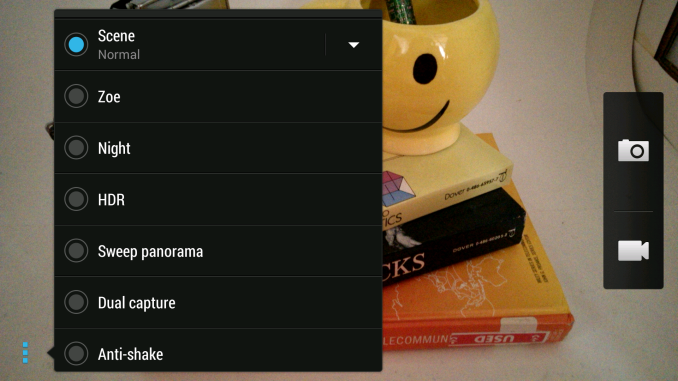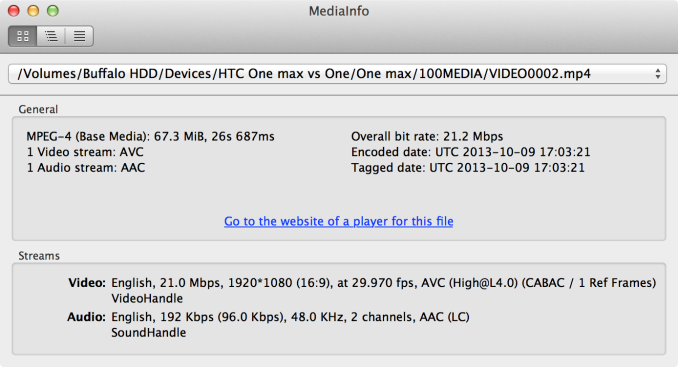HTC One max Review - It's Huge
by Brian Klug on October 28, 2013 10:00 AM EST- Posted in
- Smartphones
- HTC
- Mobile
- One
- Snapdragon 600
- Android 4.3
- One max
On the camera side we see HTC’s continued use of the 4 MP UltraPixel camera sensor on the back, with 2.0 micron pixels and 1/3" size. It’s the same CMOS sensor from ST (VD6869), and the same optics on top, with 3.8mm focal length and F/2.0 aperture. What’s different is that the One max doesn’t have OIS (Optical Image Stabilization), just like the One mini. That’s a bit unfortunate since OIS was one of the real highlights of the One, and we’ve seen another OEM follow suit with the inclusion of OIS to good success (LG’s G2) and will likely see Samsung do the same. On the front facing camera we have an Aptina AS0260 CMOS sensor with 2.1 MP resolution and 1.4µm pixels.
| HTC One Camera Specifications | |||||
| Device | HTC One | HTC One max/mini | |||
| Sensor Size and Type | 1/3" BSI CMOS | 1/3" BSI CMOS | |||
| Resolution | 4.0 MP 16:9 Aspect Ratio (2688 x 1520) | 4.0 MP 16:9 Aspect Ratio (2688 x 1520) | |||
| Focal Length | 3.82mm | 3.82 mm | |||
| F/# | F/2.0 | F/2.0 | |||
| Optical System | 5P | 5P | |||
| OIS | 2-axis +/- 1 degree, 2 kHz sampling | No OIS | |||
My thoughts about the HTC One camera system have definitely evolved over time, though I’m still glad HTC took a big risk and went this way, I’d like to see resolution traded off a bit less in the next generation. Good imaging often takes a balanced approach, I’d love to see larger pixels somewhere around 1.65 µm and as many as possible while still being pragmatic about sensor size. I hate to bring up the iPhone 5s as a comparison point, but something without as far of a tradeoff would be great. I’m still a fan of the HTC One camera indoors where other cameras struggle, but outdoors the resolution tradeoff is definitely there. Losing OIS means losing one of the things about the One system that made it special and standout in my mind. I could understand it being gone in the One mini for cost reasons, but the One max really should’ve had it considering its mission – everything about the One, taken to the max.
There’s a couple new features in the camera as a part of Sense 5.5 as well. Dual capture has been added to the camera as a shooting mode. We’ve seen this from other OEMs – it allows the front facing camera to be superimposed on the rear facing camera, or vice versus.
It’s a great feature for taking a selfie in front of something while traveling, which is ultimately its primary use case, I guess. There’s also an ‘anti shake’ mode which seems to be an EIS enhanced mode, but again this doesn’t preclude getting blurry pictures when the One max takes longer exposures, from what I’ve found.
Gallery: Smartphone Camera Bench
With the exception the performance tradeoff that comes from lacking OIS (higher chance of getting blurry photos from hand shake), imaging performance on the One max is really unchanged versus the One or One mini. I’m not going to go into super great detail here, but again I’d love to see the future One series a bit more resolution without trading off too much sensitivity.
Video
The One max has the same set of video modes as the other One, normal 1080p30, slow motion video, fast HD (720p60) and Video HDR (1080p30). In addition the shot in shot mode also works in video, so you can have yourself superimposed over video of whatever you’re shooting as well.
Video is recorded at a maximum of 1080p30 H.264 high profile with a 21 Mbps bitrate, and stereo audio. 1080p30 is great, but it’d be awesome to see 4K UHD video record which I was spoiled by on the Note 3, that’s another thing that’s a matter of SoC and CMOS needing a bit more.
I took videos on the One max at the standard bench location (MP4) and also compared to the One with OIS to illustrate the tradeoff in stabilized video that comes with its removal. I think it’s fairly easy to make the case that it should’ve been there. I also swear I wiped down the One max front facing glass to prevent glare, but the One max video shows some haze from light leakage. I’d love to see more OEMs move to coated sapphire cover glass on the camera, something I don’t believe HTC has.























































197 Comments
View All Comments
whatsa - Sunday, November 3, 2013 - link
Yes I have to admit brian has some odd perspectives at times.I find it easier when I remind myself that
" Es not the Messiah! - Es just a naughty naughty BOY!"
Impulses - Monday, November 11, 2013 - link
I could see something like Meenova's reader coming a mile away once USB OTG support became common place... I'm just surprised it took a Kickstarter campaign to make it a reality, and that it isn't more popular given this apparent need for removable storage amongst enthusiasts.I also thought we'd see USB OTG flash drives before we saw a USB OTG reader.... Though I guess it wouldn't be much smaller since you can't hide the flash memory inside the male connector itself like some of the full size USB microSD readers do.
UltraTech79 - Sunday, November 10, 2013 - link
Stupidly large.jshsimpson1 - Friday, November 15, 2013 - link
most note users do use their pens. I have the note 2 and the spend in one of the reasons I bought it among it being awesome. I love snote and I use it alot. I have a flip case which turns into a stand so that is useful for writing.fokka - Monday, December 9, 2013 - link
in the chart comparing the one/mini/max on the first page the mini is stated to have 4x krait 200 cores. as i understand, the mini is dualcore only and looking at the info on this page http://www.qualcomm.com/snapdragon/processors/400i believe it uses krait 300 cores because it's clocked at 1,4ghz.
hangfirew8 - Tuesday, December 17, 2013 - link
As always I really appreciate the depth and clarity of Brian's reviews. I've noticed one thing really missing from all, and perhaps that is because review hardware simply doesn't come with this accessory- car docks are not mentioned. After struggling with a poorly implemented car mode on the HTC Thunderbolt, I am very curious how well it works with the HTC dock. After all, one really good reason to buy a phablet over a normal size phone is that a phablet is the ideal form factor for a satnav app running docked. (Another good reason is to ditch a separate e-reader and just carry one device, not really a flaw in the review but this isn't really mentioned. I'm sure many buyers have this in mind when they buy that really, really big phone.acruhl - Saturday, April 12, 2014 - link
Sorry, I haven't read all posts. I liked the review for the most part. And I see someone was in Tucson to take the video, cool. I'm in Tucson.The HTC one max is my first smart phone (!) and I've been around since the early 70's. I got away with a pay as you go phone and an ipod up until now.
I wanted a bigger phone that could be used more like a laptop in a pinch for a new job I'm getting. I might need a keyboard for cli stuff, and using something like VNC is easier on a bigger, higher resolution screen is better.
For me, lots of this nitpicky stuff doesn't matter. I wanted a high quality, large screen and something I could hold onto reasonably well. The Mega doesn't have the screen quality. The Note is built around the stylus which I won't use. The SD card slot helps because I want to store all 30+ gigs of my music plus a few more gigs of videos (work related) on the phone. Not possible with the internal storage and software build.
Can someone explain to me why CPU speed is so important on a phone? For my laptop/home computer, the only thing I need CPU for is games or if I need a virtual machine to get a certain type of job done. Otherwise, I can wait, it's not a big deal. Even the virtual machine using my CPU isn't a huge problem, I'm patient :)
Tech for tech's sake is not productive. I haven't needed a faster CPU in my laptop or home computer for years. Memory, sure :)
The deal breaker for me on this HTC is the rattling vibration feedback. Holy cow, what were they thinking? But I don't like the other big phones so I have to decide if I can live with it.